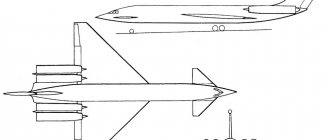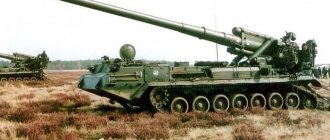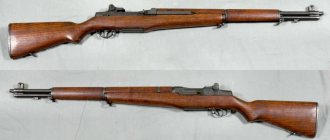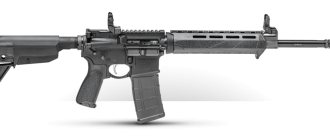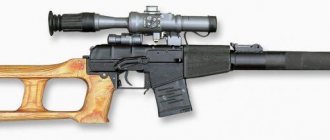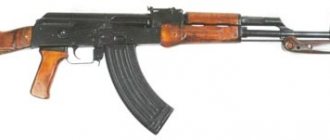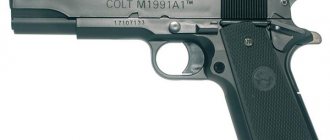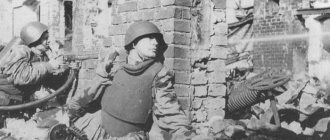| type 56 | ||
| Type 56 with folded bayonet. | ||
| Type | Assault rifle | |
| Country of origin | China | |
| service history | ||
| In service | 1956–present | |
| operators | See users | |
| wars | Vietnam War Cambodian Civil War Laotian Civil War Cambodian-Vietnamese War Sino-Vietnamese War Salvadoran Civil War Soviet War in Afghanistan Iran-Iraq War Sri Lankan Civil War Croatian War Bosnian War Kosovo War Afghanistan War Iraq War Civil War in Syria Yemeni Civil War (2015–present) [1] | |
| production history | ||
| Designer | Mikhail Kalashnikov [2] | |
| developed | 1956 | |
| Creator | Norinco | |
| Produced | 1956–present | |
| Quantity | More than 50 million | |
| options | Type 56-1, Type 56-2, Type 56-1С, Type 56С | |
| Characteristics | ||
| Weight | 3.8 kg | |
| Length | 874 mm | |
| barrel length | 414 mm | |
| Ammunition | 7.62 x 39 | |
| Caliber | 7.62 mm | |
| shooting system | Gas-operated, rotary bolt | |
| rate of fire | 650 rounds per minute | |
| operating range | 400 meters | |
| Charger | curved retrievable, 30 rounds | |
| Maximum speed | 710 m/s | |
| [edit data in Wikidata] | ||
Type 56
- an assault rifle manufactured in China since 1956. It is a Chinese version of the Soviet AK-47, from which it differs in having a built-in folding bayonet. Its aluminum and plastic magazines fit both AK and Finnish Rk 62.
Story
In the post-World War II era, the newly created People's Republic of China was a "close friend" of the Soviet Union, so it was only natural that the much less developed Asian giant would adopt the weapons of its more advanced ally. In 1956, the Chinese army adopted two Soviet military models bearing the same name Type 56 and firing the Soviet 7.62x39 cartridge: the semi-automatic Simonov SKS carbine and the Kalashnikov AK-47 assault rifle. Both weapons were produced in large quantities and used by the People's Liberation Army. (EPL) and also exported to various countries.
The original Type 56 was an almost exact copy of the Soviet AK-47 with its mechanized receiver. Chinese designers later changed its receiver to a stamped AKM, under the same Type 56 designation. The only noticeable differences were Chinese markings instead of Russian and an integral folding pointed bayonet, replacing the detachable Soviet original.
In the early 1980s, the PLA adopted a new domestically produced assault rifle known as the Type 81, which gradually replaced the Type 56 rifles in service. The Type 56 is still produced by state-owned Chinese factories in various versions for export. NORINCO Corporation also sells civilian versions of the Type 56 rifles, which are semi-automatic only and use a variety of cartridges, including 7.62 x 39 M43 and 5.56 x 45 NATO.
Another interesting note: Chinese designers produced a compact version of the Type 56, known as the Type 56C. Apparently, it is still in service with the PLA, despite the fact that its “full-size brothers” have been removed from general PLA service.
Links
ATS AK-55/AMD-63 • ČZ 2000 • Kbk AK/Kbkg wz. 60 • Kbk wz. 88 Tantal • PM md. 63 • PA md. 86 • MPi • NGM-81 • Wieger StG-940
Others AR-M1 • APS 95 • EMER K-3 • Galil • Galil ACE • INSAS • Kbk wz. 96 Beryl • Valmet Rk. 62, 76, 95 • Vektor R4 • Truvelo Raptor • Zastava (M21 • M64/M70 • M77B1 • M80 • M90) • Type 56 • Type 81 • Khazri
Shortened 300 mm barrel AMD-65 • AMP-69 • AK-102/104/105 • MPi-AKS-74NK • KALANTAK • PM md. 80/ Bullpup K-3 • Kbk wz. 2002 BIN • Kbk wz. 2005 Jantar • Type 86S • Valmet M82 • Vektor CR-21 • Groza • Vepr Machine guns INSAS LMG • Type 80/86 • UKM-2000 • • Pecheneg • AEK-999 • Zastava (M84 • M72) • PU-21 • RPK • RPK-74 Sniper rifles Galatz • PSL • Tabuk • SVK • Zastava (M76 • M91) • Valmet M-78/83S • GOPAK Submachine guns AK-9 • Bison • Vityaz • Cheetah Self-loading carbines Vepr • 18.5 KS-K • Saiga ( • • 410) Submachine guns Type 36 • Type 64 • Type 79 • Type 82 • Type 85 • CF-08 • CF-05 • CS/LS06 • CS/LS5 • CS/LS3 • CS/LS2 • QCQ-05 • QCW-05 • Slot machines Type 56 • Type 63 • Type 81 • QBZ-03 • QBZ-95 • QBS-06 • ZH-05 Sniper rifles Type 79/85 • AMR-2 • FY-JS • JS 7.62 • M99B/M06 • QBU-09 • QBU-10 • QBU-88 • LR-2A Machine guns Type 53 • Type 53/57 • Type 56 • Type 58 • Type 67 • Type 74 • Type 80/86 • Type 81 • QJY-88 • QBB-95 • Hua Qing Minigun • CS/LM12 Heavy machine guns Type 54 • Type 58 • Type 77 • Type 85 • QJZ-89 • QJG-02 • W85 • CS/LM5 Hand grenade launchers Type 54 • Type 69 • Type 79 • Type 91 • QLG-10 • FHJ-84 • PF-89 Automatic grenade launchers LG3 • LG6 • QLZ-04 • QLZ-87 • QLB-06/QLZ-87B ATGMs and recoilless rifles Type 52 • Type 65 • Type 78 • PF-98 • Red Arrow MANPADS HN-5 • FN-6 • QW-1 • QW-3 Mortars Type 53 • Type 55 • Type 56 • Type 63 • Type 64 • Type 67 • Type 87 • Type 89 • Type 93 • Type 89 Flamethrowers Type 58 • Type 74 Hand grenades Type 1 • Type 3 • Type 542 • Type 59 • Type 67 • Type 73 • Type 77-1 • Type 82-2 • WY-91 • JYS-1 • JYB-1 • JYD-1 • SC-2 • SC- 2 Guns Hawk • LW-3 • QBS-09 Ammo 5.8×21 mm • 5.8×42 mm • 7.62×25 mm TT • 7.62×39 mm • 7.62×54 mm R • 12.7×108 mm • 14.5×114 mm Italic experimental (not accepted for service) samples have been identified
Description
The Type 56 is a gas operated, bolt action, selective fire rifle. The drawer mechanism in the first versions was made of multilayer steel. Later models, however, were manufactured with a stamped steel receiver but retained the same designation. AK magazines fit Type 56 and vice versa. The Type 56 has the controls of an AK-47 with a bolt handle and safety/fire selector lever on the right side of the weapon. The pistol grip, stock and fore-end are made of wood, and a compact version with a folding stock is also available (designation Type 56-1). Alternatively, a version with a right-folding stock is known as the Type 56-2, similar to those found on the Israeli IMI Galil, Finnish Rk 62 and Belgian FN FAL. The only visible difference from the AK-47 is a fixed bayonet located near the muzzle of the weapon, which folds under the barrel and back when not in use. Some sources said that the quality of this weapon was worse than that of the Soviet original. At least a number of Type 56 rifles did not have chrome plating on the bore and exhaust port, so they were much less resistant to corrosion.
Notes
- [www.defenseimagery.mil/imagery.html;jsessionid=9B6C47D99D7864D5BB748D6BF26B9C13#guid=80ce93d60545c874bea38291b28631807dfab4c7 defenseimagery]
- ↑ 1 2 3 4 5 6
Jones, Richard D.
Jane's Infantry Weapons 2009/2010
. Jane's Information Group; 35 edition (January 27, 2009). ISBN 978-0-7106-2869-5. - [www.bdmilitary.com/index.php?option=com_content&view=article&id=202&Itemid=95 Type 56 Submachine Gun.] Retrieved on October 28, 2008.
- [www.marines.mil/unit/marforaf/_layouts/imagemeta.aspx?image=www.marines.mil/unit/marforaf/PublishingImages/090616-M-3107S-0461.jpg Marines.mil - The Official Homepage of the United States Marine Corps]
- [www.smallarmssurvey.org/files/sas/publications/w_papers_pdf/WP/WP4_Cambodia.pdf Small Arms Survey - Working Papers]
- ↑ 1 2
Miller, David (2001).
The Illustrated Directory of 20th Century Guns
. Salamander Books Ltd. ISBN 1-84065-245-4. - [mic.sd/images/products/wepons/en/MAZbn.html MAZ]. Military Industry Corporation. Retrieved February 8, 2009. [www.webcitation.org/68AWq422T Archived from the original on June 4, 2012].
Models
Type 56-2 assault rifle.
- Type 56
with fixed wooden stock and bayonet. - Type 56-1
, with a folding stock, straight pistol grip and bayonet. - Type 56-1
, with a folding stock, curved pistol grip and no bayonet. - Type 56-2
, with a right-folding stock, curved pistol grip and no bayonet. - Type 56-1C
caliber 5.56 mm with a folding stock ("civilian" version for export). - Type 56C (compact)
with a right-folding stock and a 20-round magazine.
Technical characteristics Type 56
- Caliber: 7.62×39
- Weapon length: 869 mm
- Barrel length: 414 mm
- Weight without cartridges: 4.3 kg.
- Rate of fire: 600 rounds/min
- Magazine capacity: 30 rounds
Firing a Type 56S assault rifle, Vietnam War
Assault rifles
- Austria
- Brazil
- Czech
- South Korea
- South Africa
- France
- USA
- Singapore
- Spain
- Russia/USSR
- Australia
- Finland
- Germany
- Türkiye
- Switzerland
- Denmark
- Japan
- Israel
- Sweden
- Indonesia
- Belgium
- Poland
- Ukraine
- Italy
- Croatia
- Iran
- Dominican Republic
- Mexico
- Serbia
- Argentina
- China
- Canada
- Taiwan
- Great Britain
combat history
The weapon in question was used during the Vietnam War, along with Soviet AK-47 and AKM assault rifles, by the Viet Cong Marxist guerrillas of the North Vietnamese Army against the military forces of South Vietnam and the United States between 1964 and 1975. During the Cambodian Civil War, it was used by Pol Pot's Khmer Rouge between 1970 and 1980 against the Lon Nol government. in the Laotian civil war (1962-1975) it was used by the Pathet Lao led by Souphanuvong in 1954-1975. against the government of Souvanna Phouma, overthrowing the latter 1975. It was also used in Afghanistan by anti-communist guerrillas against Soviet intervention in that country; It was used by the Iranian army against the Iraqi army in the Iran–Iraq War (1980-1988) by the Contras (US-funded) against the Sandinista People's Army (SPA), financed by the USSR and Cuba.
The EPL also used it during the Tiananmen Square massacre in Beijing on June 4, 1989 against a popular demonstration of students protesting against the Chinese communist government. In recent years, the Sri Lankan government acquired it to fight Tamil terrorist insurgents, from the Liberation Tigers of Tamil Eelam (during the Sri Lankan Civil War, 1983-2009), replacing the German Heckler assault rifle. &Koch G3 in 7.62mm caliber. Recently, in early 2008, the PLA used it in Tibet against pro-independence protesters, killing several of those who wanted to separate the said autonomous region from China.
Technical aspects
Just like the Type 56 rifles and machine gun, this rifle fires the Chinese 7.62 x 39.mm Type 56 cartridge (the national version of the 7.62mm M43 Soviet). It uses a 30-round curved magazine. It operates through a gas borrowing system. The first examples have a steel frame, but from 1965 they receive a stamped sheet metal body similar to the AKM body. 56-1 and 56-3 are also produced by stamping. This weapon functions normally even after being completely submerged in mud or water. Full chrome plating of the barrel ensures their effectiveness even at very low temperatures. All Type 56s fire semi-automatic or automatic and have an effective range of approximately 300m. Theoretically, the rate of fire is about 600 rounds per minute. In practice this becomes 100 bpm in burst mode or 40 bpm in semi-automatic mode. Type 56-1 and Type 56-2 can be equipped with a grenade launcher.
Users
- Afghanistan
- Albania
- Armenia
- Bangladesh
- Benin
- Bolivia
- Bosnia and Herzegovina
- Cambodia
- Central African Republic
- Chad
- China
- Republic of the Congo
- Ivory Coast
- Croatia
- Democratic Republic of the Congo
- Djibouti
- East Timor
- Savior
- Ethiopia
- Ecuador
- Estonia
- Finland
- Gabon
- Guyana
- India
- Indonesia
- Iran
- Iraq
- Iraqi Kurdistan
- Kenya
- Kosovo
- Laos
- Libya
- Madagascar
- Mali
- Malta
- Mexico
- Morocco
- Burma
- Nicaragua
- Nigeria
- North Korea
- Pakistan
- Palestine
- Rwanda
- Sierra Leone
- Somalia
- southern Sudan
- Sri Lanka
- Sudan
- Syria
- Tajikistan
- Thailand
- Go
- Uganda
- US
- Vietnam
- Yemen
former users
- Northern Vietnam
Operating countries
- Afghanistan Afghanistan[1]
- Albania Albania: Uses the Type 56 and its various copies.[2]
- Bangladesh Bangladesh: Produced under license by Bangladesh Ordnance Factory. Used by the special combat swimmer unit SWADS.[3]
- Benin Benin[4]
- Cambodia Cambodia[5]
- Laos Laos[2]
- Malta Malta[2]
- DPRK DPRK[2]
- Pakistan Pakistan[2]
- PRC PRC[6]
- Sri Lanka Sri Lanka[2]
- Sudan Sudan: produced under license by MAZ.[7]
- Vietnam Vietnam: actively used by Viet Cong units. Later replaced by a modernized Kalashnikov assault rifle.[6]
Chinese machines - yesterday and today
Chinese-made weapons, like Chinese products in general, have long been ridiculed for their low quality and reliability. Since domestic consumers did not have the opportunity to familiarize themselves with the samples that were produced in China, the main source of information remained cinema, thanks to which a strong negative opinion was formed about the Chinese military-industrial complex and about firearms in particular. In this article we will try to follow the development of firearms in China, and most importantly, evaluate the work of modern gunsmiths. An example for this will be one of the most popular classes of weapons - machine guns.
Type 56 automatic
Chinese machines begin their development with this model. For a long time it remained the most popular weapon, both within the country and in the export version. In addition to it, the Chinese army also had a carbine with the same designation, which was nothing more than a copy of the SKS, which can sometimes lead to confusion. The assault rifle was nothing more than a copy of a Kalashnikov assault rifle chambered for 7.62x39. But, despite the identity of the design, you should not rush to put an equal sign between them.
As the subsequent operation of the weapon showed, Chinese AKs turned out to be less reliable than Soviet ones, and the question was rather not even one of reliability, but rather the resource of the weapon. In order to simplify and reduce the cost of production of automatic machines, it was decided to abandon the chrome plating of individual parts. The result of this was a reduction in barrel life, as well as failures due to piston jamming. Adding to this the general low quality of the metal, we get the same Chinese Kalashnikov assault rifle, which was repeatedly ridiculed, but was still actively exported wherever military operations took place.
In fairness, it should be noted that not only the simplification of the design affected the reliability of the weapon. Ammunition, which was also not of high quality, also played a significant role in this.
Over the entire production period, the Type 56 assault rifle was produced in 6 variants. The Type 56 was a weapon with a fixed wooden stock and a triangular bayonet folding under the barrel. The Type 56-1 had a side-folding stock. The Type 56-2 had a modified folding stock and removed the bayonet mount. Basically, this version of the weapon was exported. The version with a shortened barrel (280 millimeters) was designated Type 56C and was essentially an analogue of the AKS-74U, but chambered for 7.62x39. For the civilian market, the Type 56S and Type 84S were produced, the latter chambered in 5.56x45. Over all this time, according to official data, more than one and a half million Type-56 assault rifles and its modifications have been produced in China.
Automatic Type 63 and Type 68
If the previous model of weapon was actually a copy of the Klashnikov assault rifle, then this assault rifle is already a clear step forward towards the independent development of weapons. Work on this machine gun was completed in 1963, but it was put into service only in 1968, which is why the weapon can be found under two different designations.
The appearance of the Type 63 assault rifle is very similar to the SKS carbine, but inside it is a Kalashnikov assault rifle. Apparently the Chinese designers decided to take the best from both models, and although the result turned out to be less convenient to use than the original versions of the weapon, it had its own certain advantages over both the AK and the SKS. In addition, one cannot help but note the resourcefulness of the designers, who managed to use individual parts of both samples to the maximum. What happened in the end?
The result was an assault rifle that was more accurate than the Type 59, having a slide stop and a large distance between the rear sight and the front sight, but at the same time bulky and less ergonomic, poorly suited for shooting from awkward positions. The total length of the weapon was more than a meter, with a barrel length of 531 millimeters. The weight of the Type 63 was 3.8 kilograms.
This machine gun was in service with the armies of Albania, Afghanistan, Cambodia and Vietnam for a long time, and was exported to African countries.
To be objective, this weapon did not have any obvious advantages over the Type 59. The main disadvantage was the overall length, which made it difficult to use the weapon in urban areas and in forests. The Chinese army abandoned this machine gun ten years later in 1978.
Automatic machines CQ 5.56, CQ-311 and CQ 311-1
In the early 80s, Chinese copies of the Kalashnikov assault rifle were already known to everyone for their negative qualities, at the same time, these weapons were captivating with their price, which led to high demand, so in general China had quite a good profit from the sales of these assault rifles. Of course, some adjustments were made by Soviet weapons, as well as those samples that were produced in the Warsaw Pact countries under license, but, due to their higher cost, they could not compete in mass production with Chinese weapons.
The business needed to be expanded, and what machine was next in popularity and popularity? Absolutely right - M16. The calculation was quite simple: if one side, supported by the Soviet Union, uses the 7.62x39 cartridge (5.45x39 was not widespread at that time, and even now preference is given to a larger caliber in some countries), then the second side will have support from NATO, which means it will have access to 5.56x45 ammunition. Accordingly, if you offer a cheaper version of a weapon chambered for a given cartridge, it will be in demand.
This is how an unlicensed Chinese copy of the M-16 appeared under the designation CQ 5.56. In this weapon, the design of the original machine gun was completely repeated, the only difference being the source materials, the shape of the handle and fore-end. But what should have worked in theory in practice brought absolutely no profit. All exports of this variant of weapons were limited to small quantities that could not even cover the costs of organizing the production of weapons.
In an attempt to recoup the money spent, a civilian version of this machine gun was released onto the market, deprived of the ability to conduct automatic fire, under the designation CQ-311, and after a minor modernization, CQ 311-1. Various sources mention the commercial success of this weapon, but no one can document this. And in general, entering the main large arms market (USA) with an unlicensed copy of the M-16 was more than problematic.
Type 81 automatic
In 1981, the Chinese army adopted a new machine gun chambered for 7.62x39 - Type 81. This model can safely be called transitional in the development of Chinese weapons. This time it was no longer a copy of a weapon or a combination of solutions from two different samples, but thoughtful work that brought results.
Of course, you can prove with foam at the mouth that the basis was the Kalashnikov assault rifle and say that the Chinese cannot come up with anything of their own, but before that it is recommended to take part in a similar dispute about the Galil assault rifle. In fact, any modern model of weapon is in one way or another similar or based on something that existed before it, the only question is whether the design could be improved or, on the contrary, spoiled.
The main requirements when designing the Type 81 assault rifle were to increase the accuracy of fire, reduce the perception of recoil, improve the ergonomics of the weapon and reduce the time it takes to change the magazine and bring the assault rifle into combat readiness.
As a result, the weapon received a longer barrel, which, although slightly, increased the effective range of use. At the muzzle there was no longer just a flash suppressor, but actually a recoil compensator; the butt was moved closer to the axis of the barrel, which had a positive effect on the shooter’s perception of recoil. The weapon received a safety switch, also known as a fire mode translator, on the left side, under the thumb of the right hand for switching.
The total length of the machine gun is 955 millimeters with a barrel length of 445 millimeters. Weight 3.5 kilograms. In addition to the version with a fixed stock, there is also a version with a folding stock - Type 81-1.
After the adoption of this weapon, work began almost immediately on creating its own version of the low-pulse cartridge, which later became known as 5.8x42. And in the future, the Type 81 would be converted to this ammunition, even despite some nuances in the design of the machine gun.
In general, the weapon turned out to be quite good in terms of the totality of its characteristics and actually surpassed the AKM in certain parameters, however, despite this, the machine still had a fairly large length, in addition, the design of the weapon did not allow making a sample with a shortened barrel with more or less satisfactory characteristics .
Type 86 automatic
In 1986, a real Frankenstein monster appeared, namely a weapon assembled from a Kalashnikov assault rifle, a French FAMAS assault rifle, a holding handle from a Steyr AUG, and all this was in a bullpup layout. One can argue for a long time about the reasons for the appearance of such weapons; the desire to make a compact model and breathe new life into the Type 59 is quite appropriate, but, most likely, it was a kind of experiment in creating weapons in the bullpup layout and considering such a design for subsequent development . The total length of the machine gun was 667 millimeters, the length of the weapon barrel was 438 millimeters. Weight 3.59 kilograms.
The machine gun was not adopted by the Chinese army, and few people were interested in it as an export weapon. However, new ammunition was on the way, and behind it a whole generation of new, completely Chinese weapons.
Assault rifles QBZ-95 (Type 95) and QBZ-97 (Type 97)
The appearance of the QBZ-95 speaks in favor of the version that the Type 86 was not an experimental project aimed at studying the possibilities of the bullpup layout, with its possible subsequent use for a new machine gun.
This weapon entered service with the Chinese army in 1995, at which time, one might say, the Soviet 7.62x39 ammunition was abandoned as the main cartridge. The new low-pulse cartridge 5.8x42 showed more than good characteristics, and both 5.45x39 and 5.56x45 are inferior to it in a number of parameters. What reveals the potential of ammunition is no longer a copy or a compilation of various solutions, but a completely independent development, using modern materials and solutions that many manufacturers came to only a few years later.
The basis of the machine gun was automation with removal of powder gases from the barrel bore with a short piston stroke and locking the barrel bore with 3 stops. The trigger mechanism is striker-fired, and in one of the weapon variants, in addition to the possibility of automatic fire, there is also the possibility of firing with a cut-off of three rounds.
At the moment, the PLA has 3 weapon options. The first, designated QBZ-95, is equipped with a barrel of 463 millimeters, while the total length of the weapon is 745 millimeters and weighs 3.25 kilograms. The interesting thing is that despite the absurdity of installing knife pieces on a weapon in a bullpup configuration, the QBZ-95 has such an opportunity. The rate of fire is 600 rounds per minute.
For the crews of armored vehicles, paratroopers and naval forces, a shortened version of the weapon with a barrel length of 369 millimeters was developed, this machine gun is designated QBZ-95B. The total length of the weapon is 609 millimeters, weight – 2.9 kilograms. On the muzzle you can see an interesting attachment, which is designed for throwing grenades, since installing an under-barrel grenade launcher is impossible in this version of the weapon. The rate of fire of this model is reduced to 400 rounds per minute.
A light light machine gun was also developed on the basis of the QBZ-95, which is essentially the same machine gun with a longer and heavier barrel of 600 millimeters in length. The total length of the weapon is 840 millimeters and the weight is 3.9 kilograms. The rate of fire was increased to 800 rounds per minute. Food is supplied from disc magazines with a capacity of 75 or 100 rounds of 5.8x42. This weapon is designated QBB-95 LSW. It is standardly equipped with a bipod and a bayonet.
In addition to the adopted machine guns chambered for 5.8x42, there are variants of weapons chambered for 5.56x45, which appeared in 1997. The prefixes to the weapon designations remain the same, as well as the parameters, the only differences are in the ammunition. In addition, there is a version with the ability to fire with a cut-off of three rounds - QBZ-97A.
The weapon has already proven itself only on the positive side and may well compete with the products of famous weapons companies. The only question that arises is whether it is advisable to use a bullpup layout in a light machine gun. If you look for disadvantages, they are exactly the same as most samples in this arrangement. The main disadvantage is that the weapon is not very comfortable to use when shooting from the left shoulder, and this disadvantage is relevant not only for left-handed people. If the cover is located to the right of the line of fire, any sane right-handed person will shoot from the left shoulder, and not stick out his entire torso under enemy fire. Of course, for the civilian market there is a weapon version without the ability to fire automatically in 5.56 caliber.
Automatic QBZ-03
The Type 87 assault rifle was not forgotten or written off thanks to Chinese law enforcement agencies, which historically have been in quiet confrontation with the armed forces. Thanks to the patronage of law enforcement officials, work began on developing a new weapon based on the Type 87, but chambered for 5.8x42.
This model was adopted for service in 2003 and is still being successfully used by law enforcement agencies. The total length of the weapon is 950 millimeters with the butt unfolded and 725 with the butt folded. The barrel length is 440 millimeters, weight – 3.5 kilograms. Interestingly, the weapon has the ability to install a bayonet, although it is not entirely clear why it is needed, taking into account the scope of application by the end user, except to look more respectable at the parade.
It turns out to be a very interesting situation when the army is armed with a more compact model of an assault rifle, which would be more suitable for use in confined spaces and dense urban areas, while the police have weapons in a classic layout with a folding butt. To be objective, all this would look more logical if law enforcement agencies and the army exchanged weapons. But it is what it is.
Automatic CQ 5.56 Type A
Another project was not forgotten, less successful, but more interesting from the point of view of copyright, namely, we are talking about an unlicensed copy of the M16 - CQ 5.56. In 2006, a deep modernization of the weapon was carried out, the result of the work was designated as CQ 5.56 Type A or simply CQ-A. The modernization was carried out so successfully that the result was nothing more than a virtually exact copy of the M4A1. It is absolutely unknown how the issue with Colt was resolved, however, these weapons are sold quite successfully, albeit on a small scale.
What happened in the end? The end result was a machine gun weighing 3 kilograms. With the butt moved forward, the weapon has a total length of 785 millimeters. With the butt extended, the length is 880 millimeters. The barrel length is 371 millimeters. The weapon, as you might guess, is powered by 5.56x45 cartridges from detachable magazines with a capacity of 20 or 30 rounds of ammunition. Almost all parts of the Chinese version of the weapon are interchangeable with the American model, however, there are differences in materials. So there were complaints that plastic decomposes very quickly under ultraviolet rays, judging by the fact that no one else pays attention to this point, the issue has been resolved.
To be fair, it is worth noting that the Chinese machine gun is slightly cheaper than the American original, however, when purchasing large volumes of weapons, this difference no longer seems so insignificant.
Automatic underwater shooting QBS-06
All in the same 2006, the QBS-06 assault rifle was adopted by the Chinese army. This weapon is specific, as it is designed for firing underwater. Many immediately saw in it a similarity with APS, and this is partly true, but similarity does not mean copying. Still, this weapon, like the ammunition, differs from domestic ones, although the general principles are still the same.
The basis of the weapon was ammunition based on a cartridge case from a 5.8x42 cartridge. It is equipped with a long bullet, which is an ordinary hardened rod. It all works on the same principle as other ammunition for firing underwater. The bullet creates a cavitation cavity around itself and its tail part, when deflected, hits the boundary of the cavity, which leads to its stabilization. Actually, the effect has been studied for a long time and there is no point in inventing something new, since this is quite enough for the bullet to maintain its speed and direction for firing at maximum distances under water at which the target is still visible. The effective firing range under water reaches 25 meters, but it must be taken into account that with increasing diving depth this distance decreases. The weapon can also fire in the air, but the lack of any stabilization of the long bullet limits the effective firing range to 50 meters.
The machine itself is, as it is now fashionable to say, a skeletal structure. Firstly, this facilitates the movement of the bolt group in a denser environment, and secondly, water from the receiver leaves it more quickly upon ascent. The automatic system is gas-operated; on the gas outlet unit there is a regulator for switching between firing modes under water and in the air. The trigger mechanism is striker-fired, with the ability to conduct both automatic and single fire. The weight of the machine gun is 3.15 kilograms, the length with the butt folded is 680 millimeters. The machine is fed from magazines with a capacity of 25 rounds.
NAR-10 assault rifle
One of the latest developments by Chinese gunsmiths is the NAR-10 assault rifle, although in the domestic classification it is more of a light machine gun. This is a kind of further development of the QBZ-03, but already chambered for 7.62x51. As it is not difficult to guess from the ammunition, the machine gun is intended for export and when compared with similar weapon models, the Chinese model has a clear advantage, as always, in price. Only this time there is no saving on the quality of materials and the quality of individual parts. Everything is manufactured at a fairly high level.
The design of the machine gun is completely identical to the original model of the weapon. The total length with the stock folded is 785 millimeters, with the stock unfolded – 1010 millimeters. The barrel length is 440 millimeters and the weight is 4.5 kilograms. The machine is fed from magazines with a capacity of 20 rounds.
Despite the fact that five years have already passed, it is too early to talk about the success or failure of the weapon. At the moment it is in demand, but, despite the low cost, preference is still given to samples that are unified with models chambered for 5.56x45.
conclusions
It’s not difficult to notice that over the past 60 years, China has made a huge leap forward, even in the example of machine guns. Having gone from copying, and with not the best results, to completely independently developed models of weapons and ammunition. It is impossible not to notice that the main direction in the development of firearms is still concentrated on exports, since this is still a solid contribution to the country’s budget. However, the Chinese do not forget about their own needs, developing very interesting types of weapons for themselves, although not ideal, but ideal weapons do not exist. Any even the most advanced design is, first of all, a set of compromises that gunsmiths make, extracting the necessary characteristics and trying to minimize the secondary ones.
We must not lose sight of how the quality of the products was raised; low-quality materials were no longer used in important components of the weapon, without missing the opportunity to save where it is appropriate and will not affect the final characteristics.
Of course, the analogy “Chinese is low quality” will remain in the memory for a long time, however, at the moment this is no longer true. For now, the same export versions of machine guns are designed for countries that cannot afford to buy expensive weapons. But you can look at other industries, where the situation was the same 5-10 years ago, and now the products are reaching the global level and can compete with well-known brands. In the near future, a similar situation may repeat itself with firearms from the Middle Kingdom.
Dear readers!
Subscribe to us on Twitter, Vkontakte, Odnoklassniki or Facebook. Read the latest news in the smi.today aggregator!
Chinese AKM for export: Type 56-II rifle
A Gambian soldier armed with a Type 56-II (with a parachute, but without a collapsible bayonet) for training at the Senegalese military camp of Thies in July 2012.
Developed in 1965, for export only from 1966. AKM du 56, made by stamping and therefore lighter, is called Type 56-II
Where is
Type 66
.
This version does not have the Russian model's muzzle brake. As in the Chinese regulatory model, there are 2 types of shares. The presence or absence of a folding bayonet on this export version. Since 1980, the Type 56-2
with a side folding stock, but without a bayonet.
French bibliography
The Chinese rifle is described in most works devoted to the AK-47:
- Dominik Wenner, Individual Combat Weapon
, Grancher, 1977 - Dominik Wenner, Soviet weapons
, Grancher, 1980 - Edouard Ducourot, Kalashnikov Automatic
, Cheetah Editions, 1982 - Stanislas de Haldat, Kalashnikov.
AK47 conquers the world . Mermaid. 1993 - Jean Huon, The Story of a Combat-Efficient Kalashnikov
, PROP, 2011 - Collective, World Assault Weapons
, Special Missions Productions, 2008
Cultural references (comics and film)
- Model Norinco Type 56
Viet Cong symbol, FA Type 56
appears, in particular, in films or television series on the Vietnam War like
Eastern Condors
,
Hell of Duty
(TV),
Platoon
,
Back to Hell
Where
the Ball's in the Head
.
He also equips the Burmese army, true to reality, in Largo Winch 2
, and in the original Beetle comic (Albums
At Makilin Fortress
/
Hour of the Tiger
) Myanmar soldiers carry HK G3A3s (evidence of serious Jean Van Hamme/Philippe Frank documentation).
Familiar with African civil wars, he arms Somali pirates in Captain Phillips
, then Sierra Leonean soldiers and child soldiers from the RUF in
Blood Diamonds
, fighters from the Lord's Resistance Army and the Sudan People's Liberation Army in
Machine Gun
Where the Tutsi Rebels are in
Hotel Rwanda
.
The Chinese Kalashnikov also arms American allies or enemies in the Green Zone
(Iraqi soldiers) or in
Fall of the Black Falcon
(Somali militia of General Mohamed Farrah Eidid).
It is also the weapon of various thugs in Crime Story
,
District 13
(in his remake
Brick Mansions
a Norinco Type 56-2
is seen legally imported into Canada where this film was filmed),
Sabotage
Where
the Zulu is
.
But the most famous fictional robber armed with the FA Type 56-1 is Trejo (played by Danny Trejo in Heat
from Michael Mann).
Finally, he is easily recognizable on the BD album cover. For Maria
on which the said Maria carries one, without a folding bayonet, transferred (in the South American triptych
XIII
featuring
El Cascador
and
Three Watches Silver
, the Costa Verde rebels also use an AK 47 and AIM Romanian), but also
Pukhtu primo
from DOA .
- Norinco 84
- Norinco Mac-90
